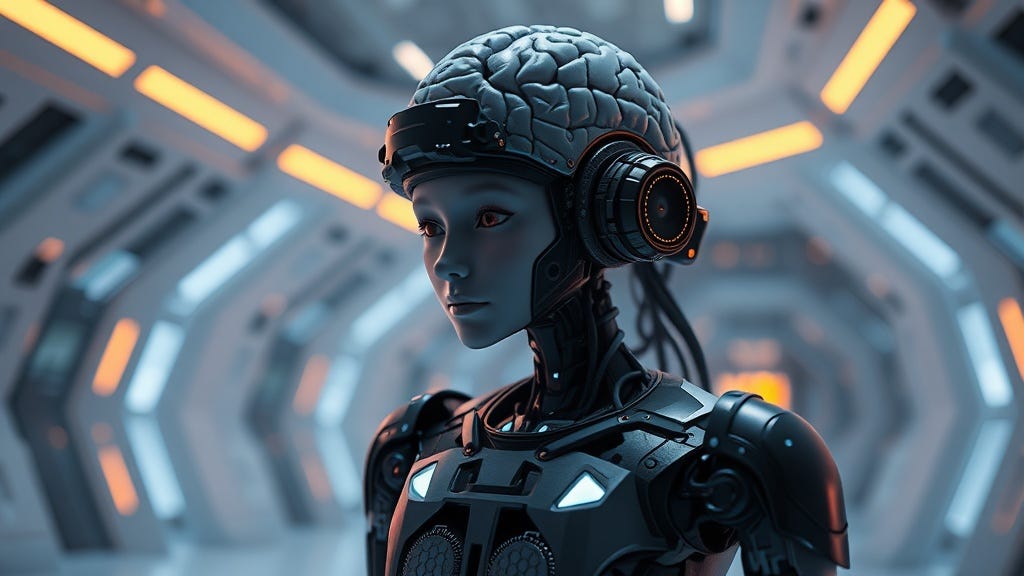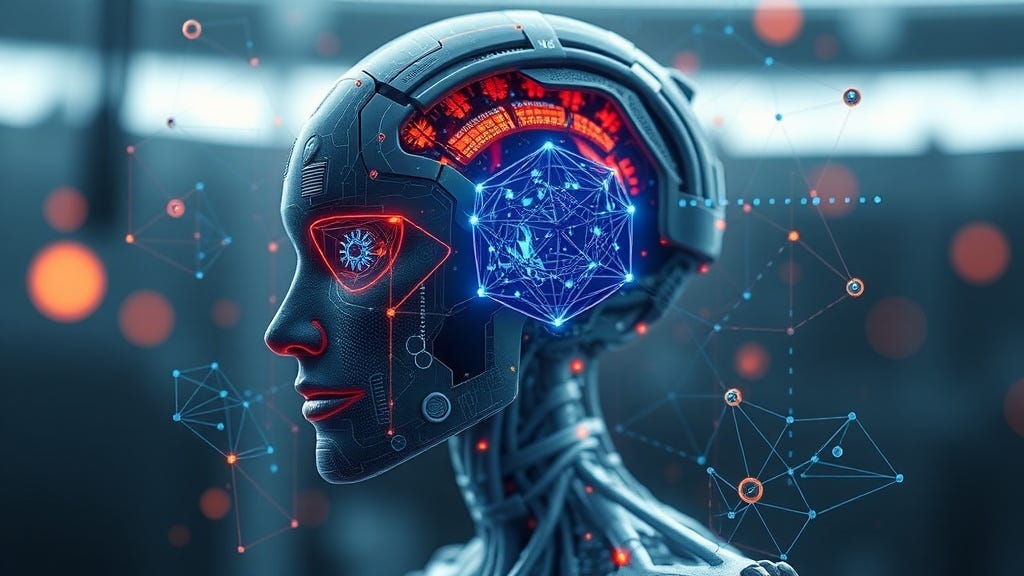Embodied Artificial General Intelligence Architecture
This post is the continuation of a journey, as I continue modernizing an embodied AGI framework idea I developed in the early 2000s, with the help of our modern AI friends (i.e. ChatGPT & Claude).
WARNING, dense reading, your nerd index should be considerably high
FIRST PART → The Behavior Framework, Embodied AGI Framework
TL;DR - Let’s just listen to a couple of AIs explain it
A Comprehensive Embodied AGI Architecture Inspired by Biological Neural Systems
Abstract
We present the Behavior Framework, a groundbreaking embodied artificial general intelligence (AGI) architecture inspired by the hierarchical structure and functionality of biological neural systems. This framework integrates reflexes, homeostatic mechanisms, emotional processing, advanced cognitive functions, and safety protocols into a cohesive software-based cognitive architecture. Designed for versatility, it is applicable across virtual contexts—such as metaverse environments, non-player characters (NPCs), and AI agents—as well as physical robotic systems. By emulating the adaptability and intelligence found in biological entities, the Behavior Framework aims to advance AGI development while ensuring ethical considerations and safety compliance. We detail each major layer of the architecture, discuss its capabilities and applications, and explore promising avenues for future research.
Introduction
The quest for artificial general intelligence requires architectures that can emulate the adaptability, learning capacity, and nuanced behaviors of biological organisms. Existing AI systems often excel in narrow tasks but lack the integrated functionality necessary for general intelligence. The Behavior Framework addresses this gap by mirroring the hierarchical structure of biological neural systems, from basic reflexes to advanced cognitive functions, all while integrating robust safety mechanisms.
Inspired by various levels of the animal kingdom—from simple reflexive organisms to complex mammals—the framework provides a scalable and adaptable architecture suitable for a wide range of applications. These include virtual environments like the metaverse, intelligent NPCs in gaming, sophisticated AI agents, and physical robots capable of complex interactions.
In this paper, we present an in-depth analysis of the Behavior Framework, detailing each layer's architecture and capabilities. By leveraging biological principles and modern computational techniques, we aim to create AGI agents that are intelligent, adaptable, and aligned with ethical guidelines.
System Architecture and Subsystems
The Behavior Framework is composed of multiple interconnected layers, each inspired by different aspects of biological neural systems. These layers work synergistically to produce coherent and adaptive behaviors. Each layer adds new capabilities and enhancements (and complexity) to the embodied agent.
1. Substrate Layer
Overview: The Substrate Layer represents the agent's physical or virtual embodiment, serving as the foundational interface between the agent and its environment.
Key Components:
Sensors: Abstract representations of environmental inputs that capture various properties (e.g., visual, auditory, tactile) and trigger based on threshold values.
Motors/Actuators/Effectors: Modules that control movement and interaction with the environment, encapsulating low-level control of physical or virtual effectors.
Embodied Surface: Defines the boundary between internal and external systems, analogous to skin in biological organisms. It houses sensors that provide fine-grained status updates at this interface.
Narrative: This layer forms the physical or virtual "body" of the agent, equipped with the necessary tools to perceive and interact with its surroundings. It lays the groundwork for higher-level processes by providing raw data and basic interaction capabilities.
2. Neural Reflexive Agent - Reflex Layer
Overview: Inspired by the spinal cord and interneurons in vertebrates, the Reflex Layer handles immediate, involuntary responses to environmental stimuli.
Key Components:
Interneurons: Connect sensory inputs directly to motor outputs, enabling rapid responses without involving higher cognitive processes.
Reflex Arcs: Simple circuits that produce automatic reactions to specific stimuli.
Narrative: The Reflex Layer provides the agent with essential survival mechanisms, allowing for quick reactions to potential threats or opportunities. By bypassing complex processing, it ensures minimal latency in response times.
3. Neural Autonomic Agent - Autonomic Layer
Overview: Drawing inspiration from the homeostatic mechanisms in the hindbrain and midbrain (Myelencephalon and Mesencephalon), the Autonomic Layer manages internal balance and physiological states.
Key Components:
Autonomic Reflex Circuits: Pairs of reflexes that work in opposition to maintain homeostasis (e.g., heating and cooling mechanisms).
Feedback Loops: Systems that adjust internal states based on sensory inputs to sustain equilibrium.
Narrative: This layer enables the agent to self-regulate critical internal parameters, such as energy levels and temperature, ensuring long-term stability and survival. It operates autonomously, requiring minimal external intervention.
4. Neural Planning Agent - Limbic Layer and Emotive Systems
Overview: Inspired by the reptilian brain and the Diencephalon of the forebrain, the Limbic Layer introduces basic emotional processing and goal-directed behaviors.
Key Components:
Emotion Subsystem: Processes lower-level emotional states like fear, pleasure, stress, and aggression.
Seeking Systems: Initiate exploratory behaviors to reconcile internal imbalances (e.g., hunger, thirst).
Sense Clusters: Integrate multiple sensory inputs to provide rich contextual information.
Narrative: The Limbic Layer equips the agent with basic drives and emotions, influencing behavior to meet fundamental needs. Emotions serve as internal signals that guide actions toward achieving homeostasis and avoiding harm.
5. Pain and Reward Networks
Pain Network:
Function: Introduces various forms of pain (physical, emotional, empathetic) as feedback mechanisms.
Safety Mechanism: Acts as a deterrent for behaviors that breach safety protocols by generating pain signals.
Reward Network:
Function: Modeled after human dopamine-based circuits, it provides positive reinforcement when actions align with goals.
Learning Facilitation: Encourages repetition of successful behaviors through pleasure signals.
Narrative: The Pain and Reward Networks work in tandem to shape the agent's behavior, reinforcing actions that are beneficial and discouraging those that are harmful or unethical. They play a crucial role in learning and adaptation.
6. Cortical Agents - Neocortex Layer
Overview: Inspired by higher mammals' neocortex, this layer handles advanced cognitive functions, including learning, pattern recognition, and decision-making.
Key Components:
Advanced Cognitive Processing: Utilizes modern neural networks (e.g., Transformers, LLMs) for complex computations.
Modulatory and Inhibitory Systems: Regulate lower-level functions and can override or adjust behaviors based on context.
Simulation Subsystem: Allows for memory replay and predictive simulations to anticipate outcomes.
Narrative: The Neocortex Layer represents the agent's "thinking brain," enabling it to process abstract concepts, solve problems, and plan for the future. It integrates information from all lower layers to produce coherent and adaptive behaviors.
7. Memory System
Overview: Serves as the repository for sensory contexts, motor actions, experiences, and their associated outcomes.
Key Components:
Spatial Memory: Stores information related to physical or virtual environments and motor plans.
Temporal Memory: Records sequences of events and actions over time.
Outcome Associations: Links behaviors with their success or failure metrics for future reference.
Narrative: The Memory System allows the agent to learn from past experiences, refining its actions and decisions over time. It supports both short-term and long-term memory functions, crucial for adaptation and learning.
8. AI Safety Subsystem
Overview: Ensures that all agent behaviors comply with predefined safety protocols and ethical guidelines.
Key Components:
Monitoring Mechanisms: Continuously assess the agent's actions for compliance.
Intervention Capabilities: Can trigger the Pain Network or restrict resources (e.g., energy, computational power) if violations occur.
Conflict Resolution: Reconciles conflicting goals or behaviors to align with safety standards.
Narrative: The AI Safety Subsystem acts as the agent's conscience, preventing harmful actions and ensuring ethical operation. It maintains trustworthiness and reliability in various applications.
9. Social AGI Layer
Overview: Represents the highest level of cognitive and social processing, managing complex interactions and societal norms.
Key Components:
Personality Subsystem: Defines unique personality traits influencing social behavior and decision-making.
Social Planner Subsystem: Manages social goals and strategies appropriate for different contexts.
Predictive Simulator and Advanced Predictive Cortex: Anticipate outcomes of social interactions and plan accordingly.
Primer Subsystem (Prime Directives): Establishes long-term goals set by the agent's owner, ensuring alignment with overarching objectives.
Narrative: The Social AGI Layer enables the agent to navigate complex social environments effectively. It allows for personalized interactions, adherence to social norms, and the pursuit of long-term goals while considering ethical implications.
10. Hive Intelligence & Training Integration Layer
Overview: Facilitates collective learning and knowledge sharing among multiple AGI agents.
Key Components:
Knowledge Sharing Platform: Allows agents to access shared memories, experiences, and learned outcomes.
Collaborative Problem-Solving: Enhances decision-making efficiency through distributed intelligence.
Continuous Learning Module: Implements ongoing fine-tuning and retraining based on new data.
Narrative: This layer mimics social learning in biological systems, enabling agents to benefit from the collective experiences of others. It accelerates adaptation and enhances performance across various tasks and environments.
Capabilities and Applications
The Behavior Framework's versatile architecture makes it suitable for a wide range of applications:
Robotics: Development of autonomous robots capable of complex interactions, environmental navigation, and adaptive learning.
Virtual Environments: Creation of intelligent NPCs in gaming and metaverse platforms that offer dynamic, emotionally responsive interactions.
AI Agents: Deployment in virtual assistants and other AI agents requiring advanced cognitive and social capabilities.
Cross-Domain Utility: Adaptable to any substrate—physical or virtual—making it a universal framework for embodied AGI.
Promising Avenues for Continued Research
1. AI Safety and Ethical Considerations
Adaptive Safety Protocols: Developing safety mechanisms that evolve with the agent's learning without hindering innovation.
Ethical Frameworks: Establishing guidelines for responsible behavior and decision-making.
2. Social Intelligence Enhancement
Dynamic Personality Adjustment: Allowing agents to modify personality traits based on experiences.
Advanced Social Planning: Improving the ability to navigate complex social dynamics and cultural nuances.
3. Pain and Reward Mechanisms
Complex Emotional Modeling: Exploring how nuanced pain and pleasure signals influence higher-order decision-making.
Behavioral Reinforcement Strategies: Refining how feedback mechanisms shape long-term behaviors.
4. Scalability and Computational Efficiency
Resource Optimization: Utilizing hardware acceleration and parallel processing to manage computational demands.
Distributed Systems: Implementing cloud-based solutions for large-scale deployment.
5. Integration of Modern AI Techniques
Continuous Learning and RAG Approaches: Incorporating ongoing fine-tuning and Retrieval-Augmented Generation to keep agents updated with the latest information.
Advanced Neural Networks: Leveraging Transformers and LLMs across all layers for enhanced capabilities.
Conclusion
The Behavior Framework represents a significant advancement in embodied AGI development, offering a comprehensive architecture that integrates biological inspirations with modern computational techniques. By mirroring the hierarchical structure of neural systems, the framework enables agents to exhibit a wide range of intelligent behaviors—from basic reflexes to advanced social interactions—while maintaining ethical integrity and safety compliance.
The incorporation of continuous learning mechanisms, such as the Continuous Learning Module and Dynamic Knowledge Integration Layer, ensures that agents remain up-to-date and adaptable in ever-changing environments. The framework's versatility across virtual and physical substrates makes it a promising foundation for future AGI applications.
As research progresses, the Behavior Framework holds the potential to revolutionize how we develop and interact with intelligent systems, paving the way for AGI agents that are not only capable and adaptable but also aligned with human values and societal norms.
















